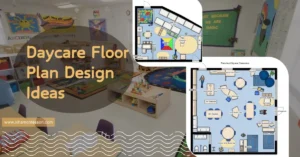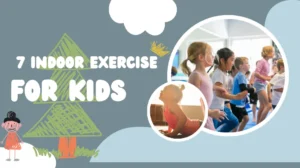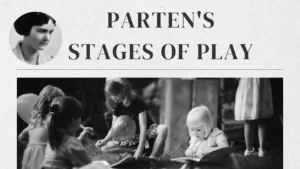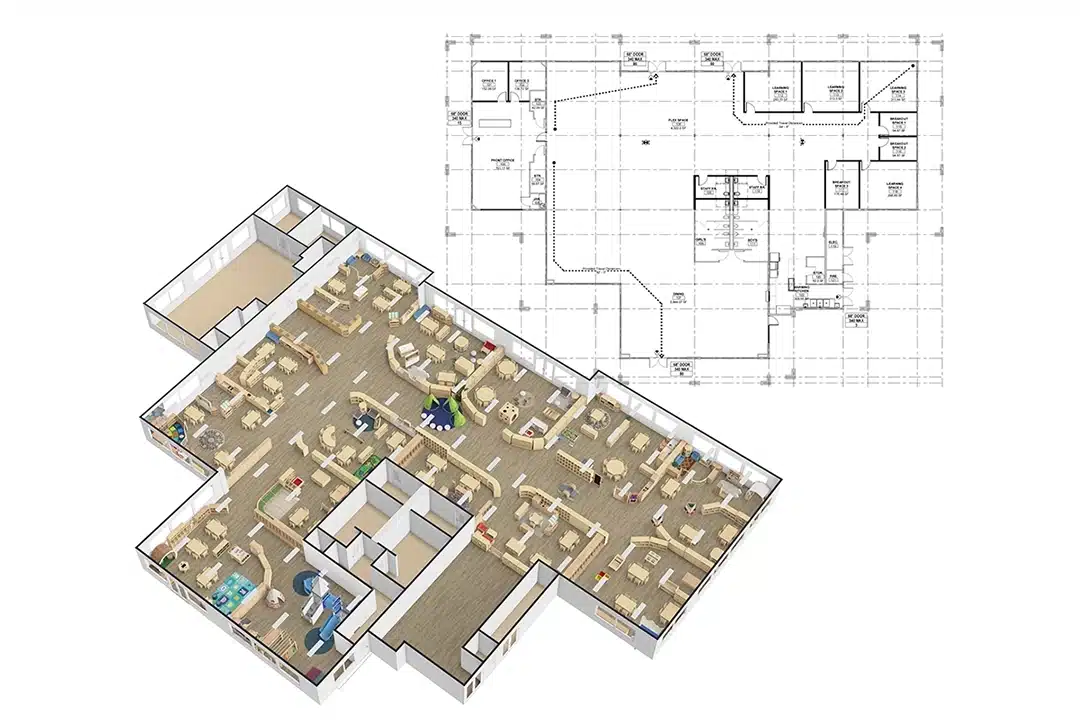Are you struggling to figure out how to clean the Pikler Triangle without damaging its surface or weakening its structure? Do you wonder how often you should disinfect it, especially when multiple children use it daily? Are you worried that an incorrect setup could pose safety risks during active play?
Learning how to clean the Pikler Triangle the right way isn’t just about keeping it tidy—it’s about protecting your child’s health and supporting their development. Proper cleaning helps prevent bacteria buildup and prolongs the life of the wood, while a safe and secure setup ensures injury-free play. A well-maintained Pikler Triangle encourages independent movement, enhances gross motor development, and builds confidence in toddlers as they climb, balance, and explore.
When it comes to setup and maintenance, every detail counts. In the following guide, we will walk you through practical, easy-to-follow steps for setting up your Pikler Triangle securely and cleaning it effectively using safe, child-friendly materials.
The Importance of the Pikler Triangle
In early childhood development, few tools are as timeless and practical as the Pikler Triangle. Initially developed by pediatrician Dr. Emmi Pikler, this simple wooden climbing frame has transformed the way children engage in physical and cognitive growth. Its genius lies in its simplicity, offering open-ended play that evolves with the child’s age and abilities.
The Pikler Triangle encourages children to explore their bodies and physical capabilities at their own pace. It nurtures independence by allowing children to climb, balance, and descend based on their readiness, not adult instruction. This freedom builds confidence and supports motor skill development, all while ensuring the child feels in control of their movement.
What makes the Pikler Triangle truly valuable is how it aligns with the core principles of Montessori and Reggio Emilia’s education. These philosophies emphasize child-led exploration, and the triangle offers just that—a safe space for children to make decisions, solve problems, and test their physical boundaries without unnecessary intervention.
Moreover, its presence in a learning environment subtly reinforces self-discipline, spatial awareness, and risk assessment. A child who learns to navigate the structure safely learns more than just how to climb; they learn patience, persistence, and resilience.
Whether used at home or in a professional setting, the Pikler Triangle is a long-term investment in a child’s development. It is not just a toy—it is a developmental tool that respects and supports the natural process of growth.
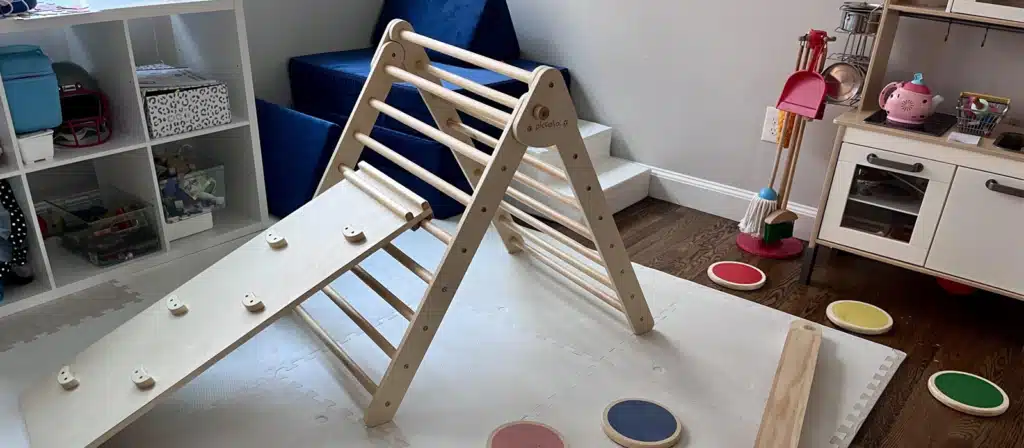
When and How to Introduce It to Children?
Introducing the Pikler Triangle at the right stage of a child’s development is essential to ensure both safety and developmental benefits. While it’s tempting to think of this structure as a climbing toy suitable only for toddlers, the truth is that it can be safely introduced much earlier—and used much longer—than most people expect.
Ideal Age to Start Using the Pikler Triangle
Most children can begin interacting with the Pikler Triangle as early as 6 months old, but not in the way you might assume. At this age, babies are not climbing yet—they are rolling, crawling, and beginning to pull themselves up. The triangle becomes a stable structure that supports these early movements. Children can grip the lower rungs while learning to balance or pull themselves upright, strengthening the muscles they’ll need for more advanced gross motor activities later on.
From around 10 to 12 months, some children may begin to explore climbing on the lower bars. This is a natural part of their risk-taking and problem-solving development. By 18 months to 2 years, many toddlers begin climbing confidently, testing their boundaries, navigating up and down, and learning how to control their bodies in space.
By age 3 to 5 years, the triangle’s benefits evolve. At this stage, children begin to combine the Pikler Triangle with other gross motor play equipment, such as ramps, slides, or tunnels, to invent new challenges. It becomes a more complex, open-ended play structure that grows with their creativity and physical ability.
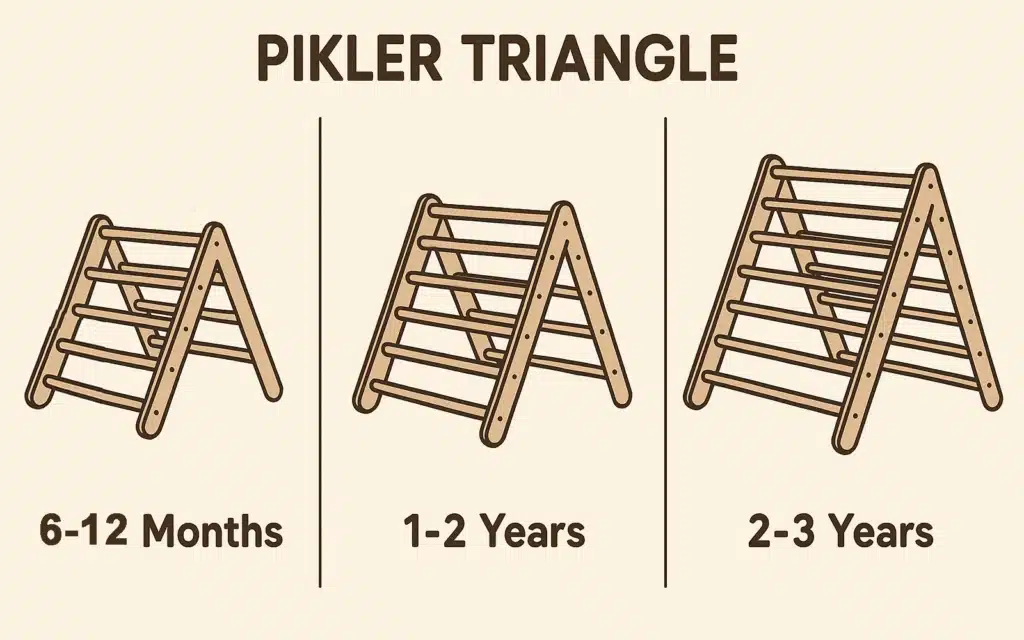
How to Introduce It in a Safe and Supportive Way
When introducing the Pikler Triangle to a child, especially a baby or early walker, it’s essential to create a supportive, distraction-free environment. Place the triangle in a quiet corner of the home or classroom, ideally on a soft surface like a foam play mat or carpet. Avoid high-traffic areas or spaces with hard edges or obstacles nearby.
Supervision is crucial, especially in the early stages. While the triangle is designed to encourage independent movement, adult presence ensures that children explore safely and with confidence. Avoid the urge to lift or guide the child; instead, observe and intervene only when necessary. This builds their ability to assess and respond to physical challenges on their own.
You can encourage engagement by placing toys, scarves, or balls near the triangle to prompt exploration. For infants, simply allowing them to reach and grab the bars is enough. For toddlers, introducing ramps or platforms gradually expands the range of physical challenges.
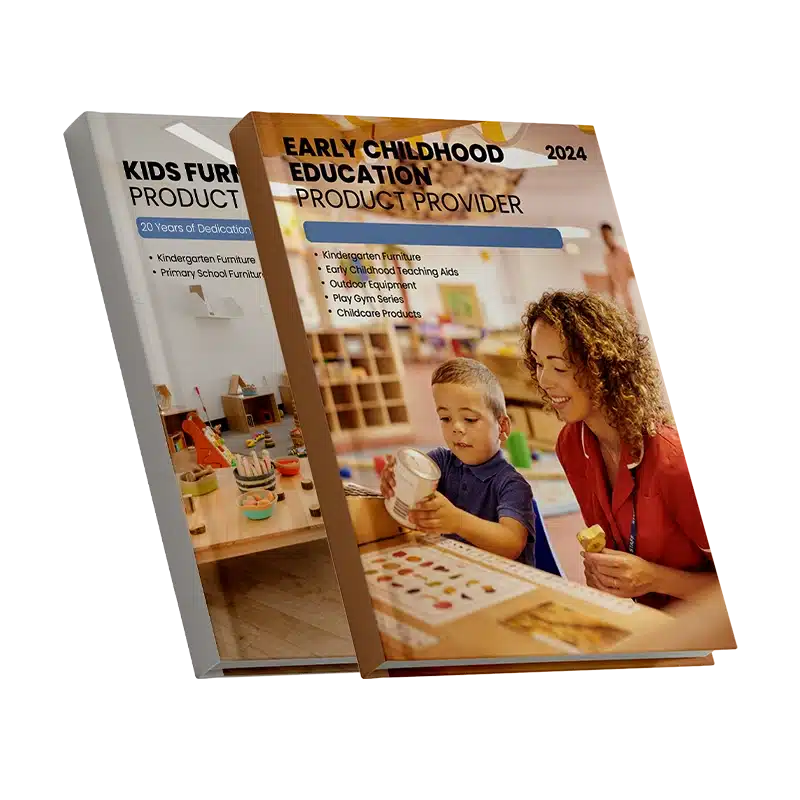
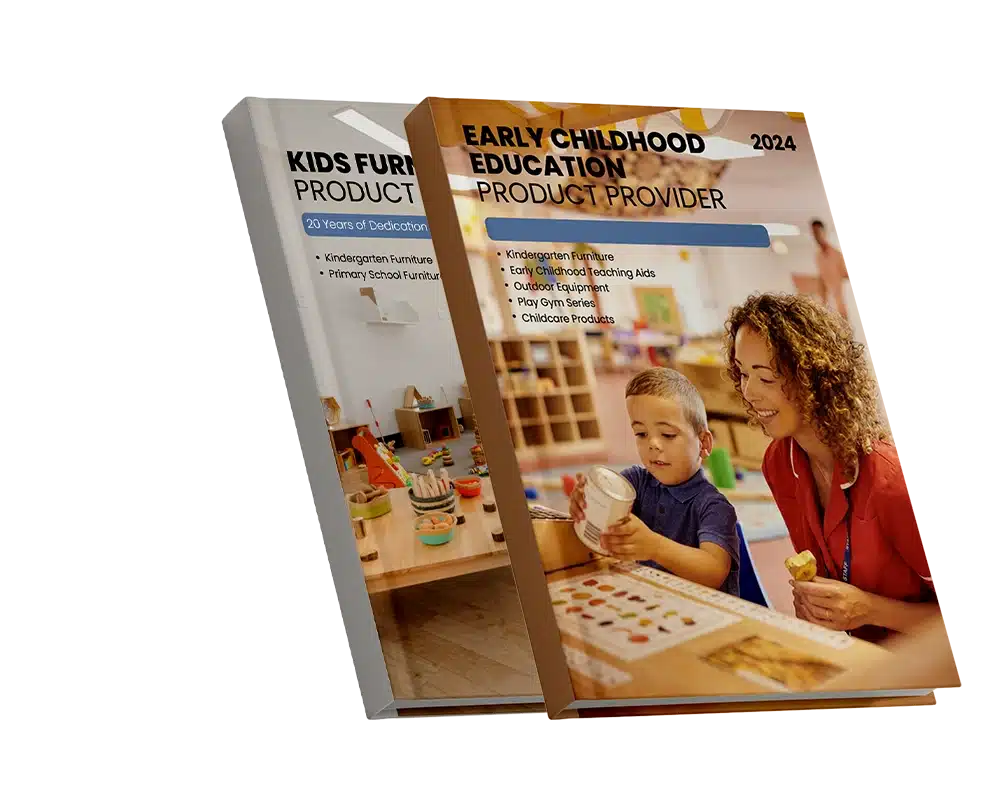
Matching Developmental Milestones
Every child is different, and their interaction with the Pikler Triangle should align with their pace. Some children may climb at 12 months, while others may wait until 20 months. The key is to let the child lead. As long as the triangle is set up safely and used on a stable surface, children can safely use it for years.
What matters most is consistency and trust. With regular access, children will return to the triangle on their own, pushing their limits little by little. You’ll begin to see improvements in coordination, balance, risk awareness, and confidence—all indicators of successful gross motor development.
Different Types of Pikler Triangles
The Pikler Triangle is a timeless tool for encouraging gross motor development, independent play, and confidence in young children. While the original concept was simple—a triangular climbing frame made from wood—modern versions have evolved to fit different needs, spaces, and stages of development. Understanding the various types of Pikler Triangles helps parents and educators choose the best option for their children or learning environment.
Classic Pikler Triangle
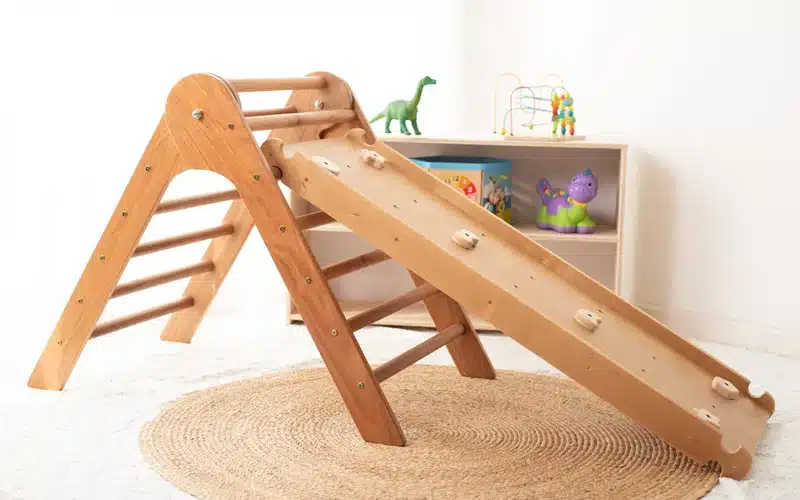
This is the traditional, fixed-size model based on Dr. Emmi Pikler’s original design. It consists of two side panels with several horizontal rungs, forming a stable climbing structure. It’s perfect for home use and ideal for babies as young as 6 months to start pulling up or cruising, while toddlers and preschoolers use it for climbing, hanging, or imaginative play.


Foldable Pikler Triangle
Designed for families or classrooms with limited space, the foldable version allows you to store the triangle away when not in use. These models often have a locking mechanism for safety and are especially popular in urban homes or small Montessori classrooms. Foldable triangles are both space-efficient and durable.
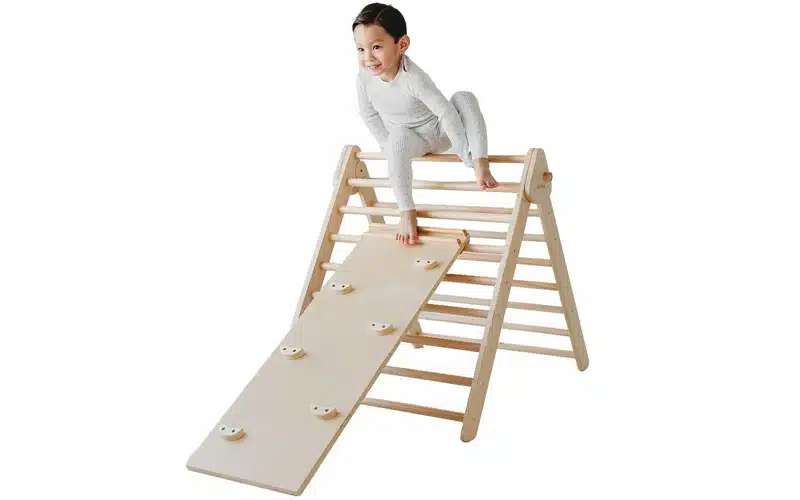
Adjustable Height Pikler Triangle

This variation includes mechanisms that allow the triangle’s angle or height to be adjusted. It grows with your child, offering more challenging climbing options as their strength and coordination improve. Adjustable triangles are ideal for long-term use from infancy to about 5 years old.
Pikler Triangle with Ramp or Slide
Some models include attachments like reversible ramps, slides, or climbing boards. These additions increase the versatility of the triangle and encourage more creative physical exploration. Children can climb up one side and slide down the other, developing coordination and problem-solving skills.
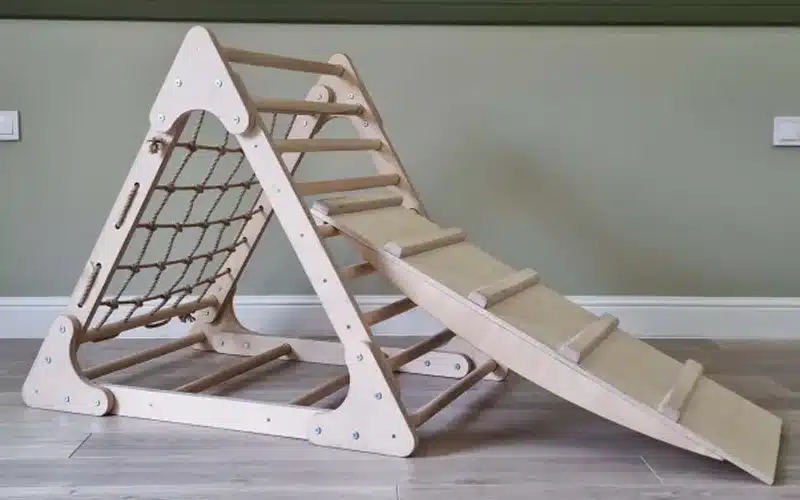
Mini or Travel Pikler Triangle

Mini triangles are smaller, lighter versions designed for travel or infants under 18 months. These models are ideal for early walkers and are easy to transport between rooms or even take outdoors. Though compact, they still offer the core benefits of the larger triangle.
When selecting a Pikler Triangle, consider your available space, your child’s age, and how long you plan to use the equipment. Classic and adjustable models are great for multi-year use, while foldable and mini options suit small homes or frequent moves. Regardless of the type, regular use and proper care—including knowing how to clean the Pikler Triangle—will ensure it remains a safe and enriching part of your child’s playtime for years.


How to Set Up the Pikler Triangle Safely and Correctly?
Setting up the Pikler Triangle might seem like a simple task, but doing it properly is critical for your child’s safety, comfort, and developmental success. The structure must be stable and inviting, especially since toddlers and preschoolers will be using it independently. Knowing how to set up the Pikler Triangle the right way gives you peace of mind and ensures that your child gains the full benefits of movement-based play. Below are several essential factors to consider during setup.
Choosing the Right Location
One of the first and most overlooked steps in learning how to set up the Pikler Triangle properly is selecting an appropriate location. The triangle should always be placed on a flat, level surface. This ensures stability and prevents wobbling during use. Avoid placing it near walls, sharp furniture edges, or in high-traffic areas. Instead, choose a spacious area with soft flooring such as a foam mat, carpet, or a Montessori play mat to cushion any potential falls.
You also want to make sure there’s adequate space around the triangle—at least 1.5 meters of clearance on each side. This helps children move freely and explore the structure from all angles. Good lighting, especially natural light, enhances visibility and makes the environment more welcoming. Setting up the Pikler Triangle in a quiet corner of the playroom or classroom promotes focus and comfort.
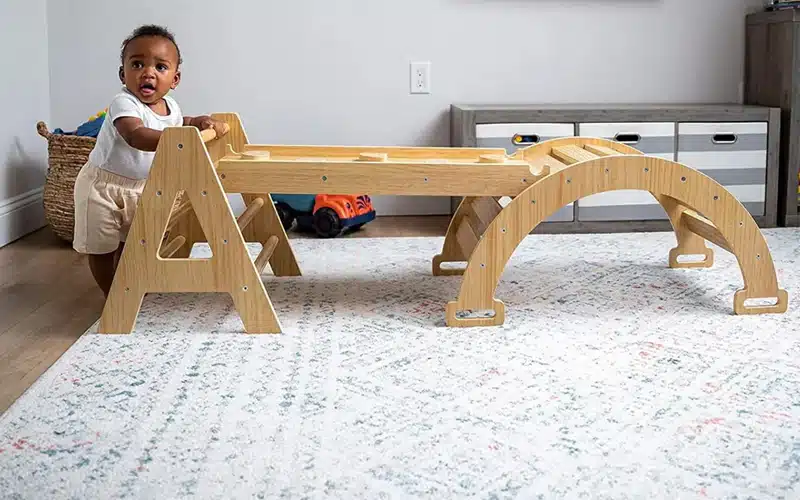
Step-by-Step Assembly Instructions
Once you’ve chosen the right spot, it’s time to set up the Pikler Triangle. Begin by laying out all parts and checking the inventory against the manual. Most Pikler Triangles include wooden rungs, two side panels, and hardware such as bolts and washers. Tools typically required include an Allen key or wrench, which is often provided in the package.
Follow the assembly instructions carefully. Start by attaching one side panel to the rungs, inserting each rung into its designated slot. After all rungs are inserted, connect the second side panel. Do not tighten all bolts immediately—leave them slightly loose until everything is aligned. Once the structure is balanced and symmetrical, you can go back and tighten all the bolts firmly. A solid, well-aligned triangle will feel sturdy and dependable.
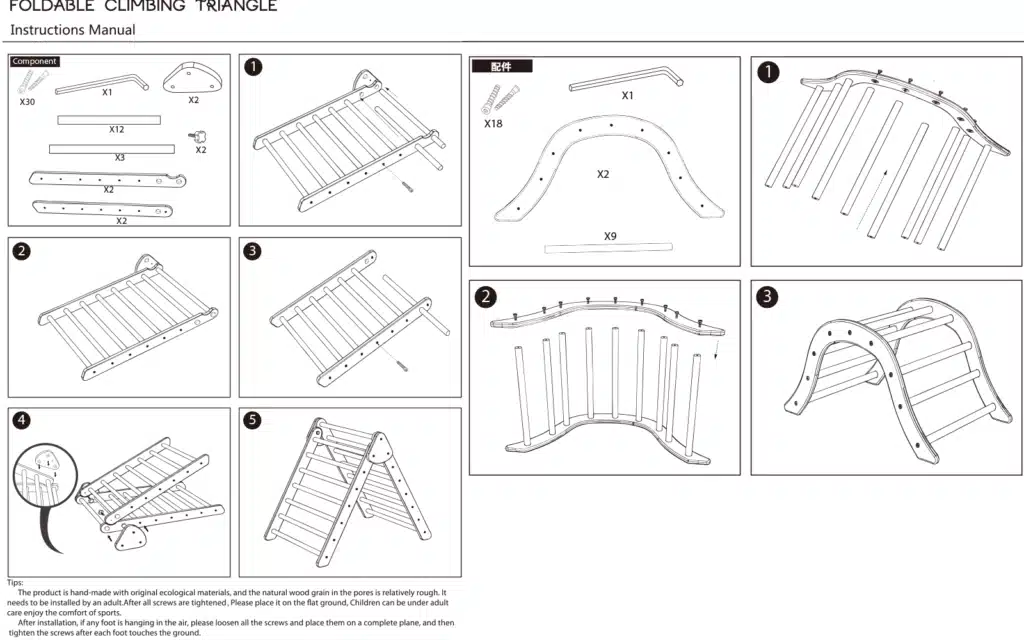
Safety Checks Before Use
The final step to set up the Pikler Triangle correctly is a thorough safety inspection. Go over every bolt to ensure they’re tight and secure. Run your hand along the surface of the wood to check for any splinters or rough edges. If any part of the wood feels uneven or sharp, sand it lightly with fine-grit sandpaper. Also, check for any visible cracks or defects in the wood.
Next, place your hand at the top of the triangle and gently shake it. If it wobbles or creaks, adjust the base or re-tighten any loose joints. If your model has adjustable parts—like foldable legs or a reversible ramp—test these mechanisms to make sure they lock securely into place. Anti-slip pads can be added to the base to keep the structure from sliding on smooth surfaces.
Once all safety checks are complete, supervise your child closely during the first few sessions. This ensures that both the setup is effective and that your child is engaging with the triangle in a safe, confident manner. When you set up the Pikler Triangle correctly, it becomes a long-lasting, enriching part of your child’s play environment.


Why is Proper Clean the Pikler Triangle Essential?
Keeping children safe, healthy, and supported in their development goes beyond just providing them with the right toys and tools. One of the most overlooked but essential responsibilities of caregivers, parents, and educators is ensuring that the materials children interact with daily are clean, safe, and well-maintained. The Pikler Triangle, used in both homes and professional educational environments, is no exception. Understanding how and why to clean the Pikler Triangle properly is vital—not only for maintaining its physical quality but also for protecting the well-being of the children who use it.
Hygiene and Safety Concerns
Young children are naturally curious, and their play often involves full-body interaction. They climb with bare hands and feet, sometimes even exploring objects with their mouths. Because of this, the Pikler Triangle quickly becomes a high-contact item, accumulating sweat, saliva, dust, food particles, and more. Without regular cleaning, these substances can form a breeding ground for bacteria and germs. In shared environments like preschools and daycares, where multiple children use the same equipment, the risk of germ transmission is even higher.
Proper hygiene practices are essential during flu season or when one child in the household is unwell. A simple routine to clean the Pikler Triangle can help prevent the spread of illness and ensure a healthier environment overall. Using mild, non-toxic cleaning solutions such as diluted vinegar or eco-friendly disinfectants is recommended, as harsh chemicals may leave harmful residues on the wood.
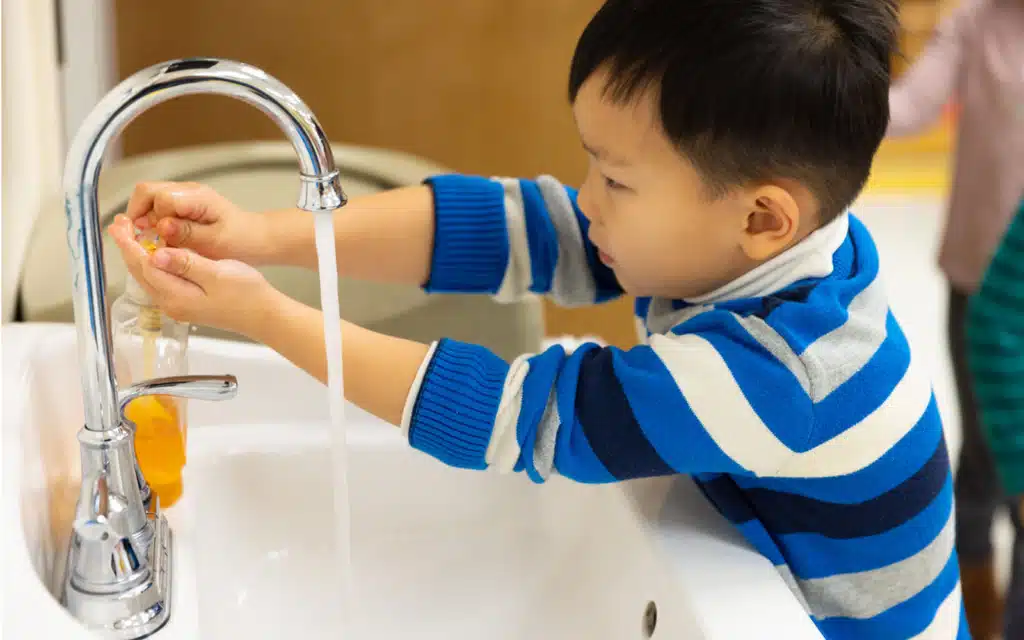
Effects of Dirt and Moisture on Wooden Materials
Another primary reason to consistently clean the Pikler Triangle is to protect the integrity of the wood. Dirt and moisture, if left unchecked, can lead to long-term damage. Wood is a natural, porous material. When it absorbs excess moisture—whether from spilled liquids, wet hands, or humid conditions—it can swell, crack, or even develop mold. Dust and grime can also build up in joints or crevices, weakening structural connections over time.
Regular cleaning keeps the surface smooth and free from buildup. It’s also an opportunity to inspect the triangle for early signs of wear, such as small cracks, loose screws, or splinters, which can be corrected before they become hazards. Maintaining the wood doesn’t just improve safety—it also keeps the triangle looking beautiful. It extends its usable lifespan, which is particularly important for educational facilities that invest in high-quality learning materials.
Child Health Considerations
The health implications of failing to clean the Pikler Triangle regularly go beyond germs. Allergens like dust mites or pet hair can accumulate on the wood’s surface, triggering allergic reactions in sensitive children. For children with asthma, even a slight buildup of dust could lead to breathing difficulties during active play. A clean surface, on the other hand, ensures that children can engage freely without being exposed to unnecessary health risks.
Moreover, a clean environment signals to the child that their space is cared for. In Montessori and Reggio settings, where respect for the environment is a key educational principle, the act of maintaining tools like the Pikler Triangle becomes part of the learning process. Children learn from example, and when adults consistently clean the Pikler Triangle, children internalize the value of responsibility and care for their belongings.


How to Clean the Pikler Triangle the Right Way?
Knowing how to clean the Pikler Triangle properly is essential for maintaining hygiene, preserving material quality, and ensuring long-term safety for children. Unlike plastic toys, the Pikler Triangle is usually crafted from natural wood, which requires special attention. Many parents and educators mistakenly believe a quick wipe is sufficient, but thorough cleaning demands a careful, structured approach. From daily care to deep cleaning routines, here’s how to clean it the right way.
Recommended Cleaning Materials and Solutions
To effectively clean the Pikler Triangle, the first step is choosing the right materials. Avoid harsh chemicals like bleach or industrial cleaners, as these can erode the wood surface and leave toxic residues. Instead, use a mix of mild, child-safe cleaning agents. A solution of white vinegar diluted with water (1:3 ratio) is a time-tested, non-toxic choice that works well for daily maintenance. For deeper cleaning, a bit of mild soap with warm water and a soft microfiber cloth is ideal.
Consider using wood-safe disinfectant sprays designed explicitly for toys. Just ensure they are free from alcohol, ammonia, and artificial fragrances. After using any cleaning solution, always follow up with a clean, damp cloth to remove any residue, and finish with a dry towel to prevent moisture absorption.

Daily and Weekly Cleaning Schedule
A structured cleaning schedule ensures you consistently clean the Pikler Triangle without missing critical maintenance steps. For home use, wiping down high-touch areas daily, such as the climbing rungs and handholds, helps eliminate sweat, dirt, and food particles. Use a damp cloth with water or your diluted vinegar solution for this.
In a daycare or preschool setting where the triangle is used by many children, daily cleaning becomes even more important. At the end of each day, do a full surface wipe-down, and sanitize especially after flu outbreaks or when children have been sick.
Weekly, take time to inspect joints and clean less-obvious areas like the undersides, inside corners, and bolt holes. These can collect dust and crumbs over time. Keeping a routine not only prevents dirt buildup but also makes deep cleaning less labor-intensive.
How to Remove Stains, Dust, and Moisture
Wood is a porous material, so if spills or stains occur, it’s essential to act fast. To clean the Pikler Triangle when stains appear, blot—don’t rub—the area with a damp cloth. Then, apply a mixture of baking soda and water to lift the surface stains gently. For persistent marks, lightly sand the area with fine-grit sandpaper and reapply a non-toxic wood polish or conditioner to maintain its finish.
Dust accumulation in corners and bolt holes can be cleared using a soft-bristle brush or a vacuum cleaner with a nozzle attachment. Moisture, especially in humid climates or from cleaning, must be wiped away thoroughly to prevent swelling or mold growth. After each cleaning, allow the triangle to air dry in a well-ventilated area—never under direct sunlight, which can cause warping or fading.
Common Mistakes to Avoid
Many well-meaning parents unintentionally damage their triangle by over-cleaning or using the wrong products. One of the most common mistakes is using too much water, which seeps into the joints and weakens the wood over time. Another is scrubbing too harshly, which strips away protective coatings or damages the wood grain.
Avoid using disposable antibacterial wipes unless they are specifically marked as wood-safe and alcohol-free. These often contain chemicals that dry out the wood or cause discoloration. Also, never leave the triangle damp overnight. Always ensure it is fully dry before the next use.
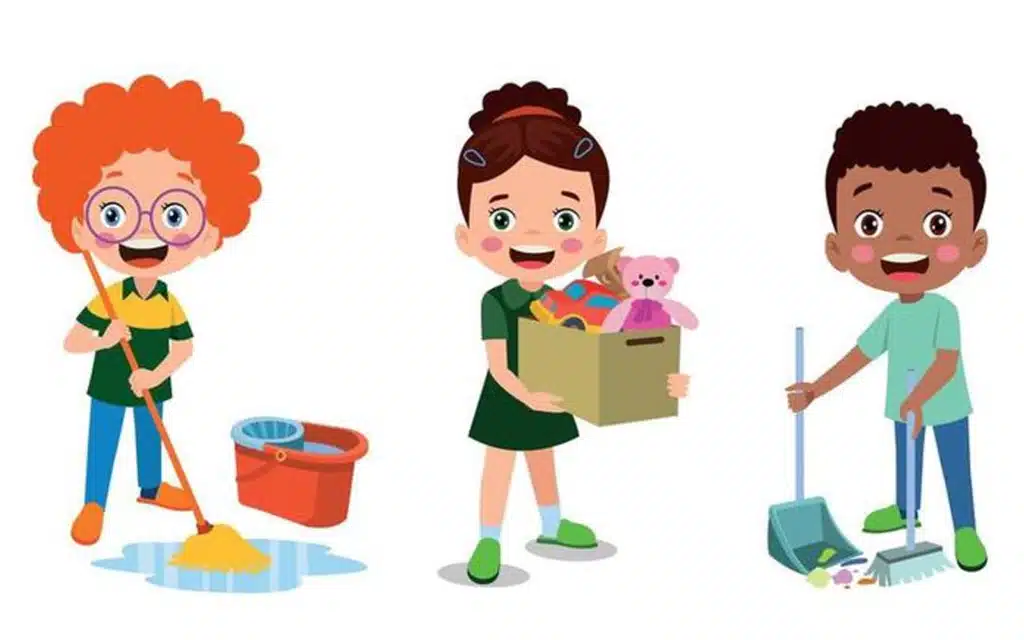
When to Tighten or Check Screws
Regular structural inspections are just as important as cleanliness. Over time, movement and weight will cause bolts and screws to loosen, especially in high-use settings like classrooms. Once a month—or bi-weekly in schools—check all bolts, nuts, and connecting joints. Use the appropriate tool, often an Allen key, to gently tighten any that feel loose.
Do not over-tighten, as this can strip the wood or damage the hardware. Look for signs of wear, such as slight wobbling, creaking sounds, or uneven alignment. These are often early warnings that the structure is becoming unstable. By catching these signs early, you avoid potential safety risks and extend the triangle’s lifespan.
While you’re checking the screws, it’s also a good opportunity to clean the Pikler Triangle more thoroughly. Disassemble small sections if necessary to reach dust or dirt buildup in the inner corners, especially in folding models or those with attached ramps.
How to Store It When Not in Use
Proper storage is often overlooked, but it’s a key component of maintenance. If you’re not using the triangle daily—whether due to travel, seasonal needs, or space constraints—it must be stored correctly to avoid damage. Choose a cool, dry indoor space away from direct sunlight and moisture. Sunlight can cause fading or uneven discoloration, while dampness may lead to mold or wood swelling.
Before storing, always clean the Pikler Triangle thoroughly to remove dust, oils, and any grime from regular use. Allow it to air-dry completely before folding or stacking it. Never cover it in plastic, as this can trap moisture. Instead, use a breathable cotton sheet or fabric cover.
For foldable triangles, ensure the locking mechanism is secure and that no pieces are putting pressure on one another during storage. Lean it gently against a wall or lay it flat on a padded surface—never in an upright position where it could fall.
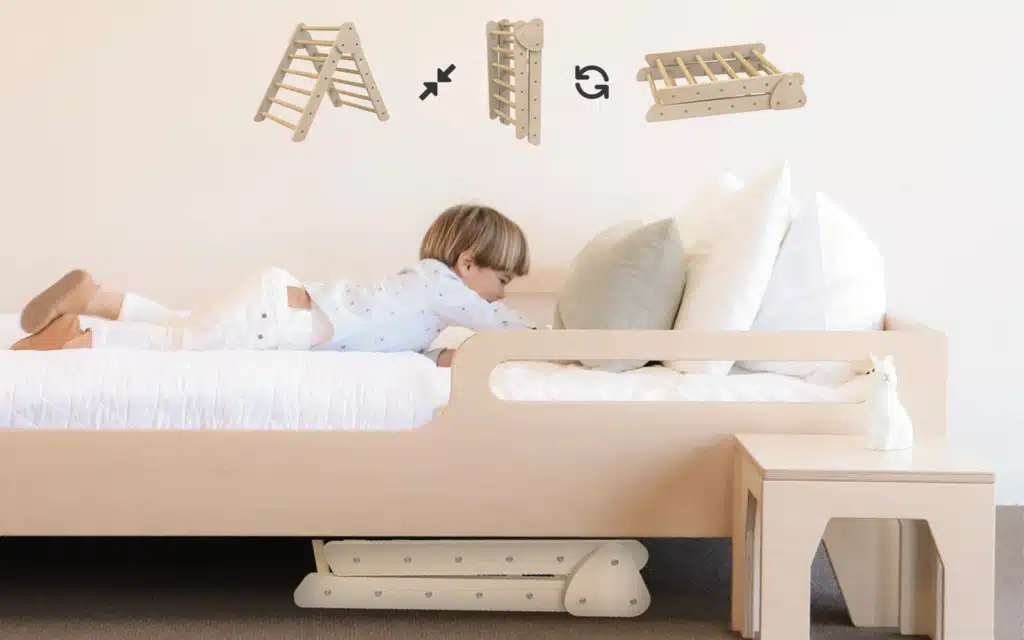
Safety Guidelines Every Parent or Teacher Should Know
The Pikler Triangle is a powerful tool for promoting independence, coordination, and gross motor development. But like any physical learning material, its benefits are fully realized only when it is used safely and responsibly. Whether you’re a parent introducing it at home or an educator managing a classroom full of active toddlers, there are essential safety practices to follow. These ensure that children use the triangle as intended—freely and confidently, but within safe boundaries.
Always Set Up the Pikler Triangle on a Stable Surface
The very first step in ensuring safety is to set up the Pikler Triangle correctly. It should always be placed on a level, non-slippery surface. Ideal locations include carpeted floors, rubber play mats, or wood floors with non-slip padding underneath. Avoid hard tile or slick surfaces unless a protective mat is used.
The setup area should have at least 1.5 meters of clearance around the triangle to allow children to move freely and reduce collision risks. Never position the triangle near sharp furniture edges, heaters, or against walls where children could get trapped or bump their heads.
After assembly, gently shake the structure to check its stability. If there’s any movement or creaking, recheck bolts and joints. An improperly set up Pikler Triangle can wobble, increasing the risk of tipping over, especially when multiple children are climbing.
Supervise, but Don’t Intervene Too Quickly
One of the core principles behind the Pikler Triangle is encouraging self-initiated movement. Children learn best when allowed to explore their physical boundaries. That said, supervision is non-negotiable, especially for infants and toddlers under 3.
However, supervision doesn’t mean interference. Allow the child to take their time climbing, descending, or problem-solving. Intervening too quickly can disrupt their confidence. Instead, stay close, observe, and step in only when safety is genuinely at risk (for example, if a child is climbing unsafely or looks unbalanced at the top).
Dress Children Appropriately
Safe use of the Pikler Triangle also depends on how children are dressed. Avoid clothing with long strings, baggy sleeves, or anything that could get caught on the bars. Bare feet or non-slip socks are best, as they give children better grip and control while climbing.
Remove accessories like scarves, necklaces, or dangling items that may pose strangulation risks. Teach older children to take turns and respect space when more than one child wants to play on or around the triangle.

Inspect Before Each Use
No matter how sturdy the triangle is, regular inspections are essential. Look for any loose screws, structural misalignments, or visible damage. If you notice splinters or cracks in the wood, the equipment should be taken out of service until it is repaired.
Be especially attentive if your Pikler Triangle is foldable or adjustable, as hinges and locks may become loose over time. Before each use, test the mechanism to ensure it is fully secure.
FAQs
1. How often should I clean the Pikler Triangle if it’s only used indoors?
Even when used exclusively indoors, it’s essential to clean the Pikler Triangle at least once a week. Dust, sweat, and small particles from children’s hands and feet can build up quickly. More frequent cleaning is recommended during flu season or when shared by multiple children.
2. What’s the best way to clean the Pikler Triangle after outdoor use?
If you take it outdoors, always clean the Pikler Triangle immediately after. Use a damp cloth to remove dirt and debris, and follow up with a dry towel to prevent moisture absorption. Never leave it in direct sunlight or wet environments overnight, as this can damage the wood and reduce its lifespan.
3. Do I need special tools to set up the Pikler Triangle at home?
Most models come with basic tools like Allen keys or small wrenches. To set up the Pikler Triangle securely, you’ll typically need only a screwdriver and a clean, flat surface. However, it’s critical to follow the manufacturer’s instructions closely to ensure every bolt and joint is safely aligned.
4. Can I clean the Pikler Triangle with baby wipes?
Some baby wipes are safe, but many contain alcohol or chemicals that can harm wood surfaces. To safely clean the Pikler Triangle, use a non-toxic solution like diluted vinegar or a mild soap and water mix. Always dry it thoroughly after wiping to avoid wood damage.
5. What should I do if the Pikler Triangle starts to wobble after setup?
A wobbling frame usually means the structure wasn’t fully secured during assembly. To fix this, revisit the instructions and check how you set up the Pikler Triangle. Make sure all screws are tight and the unit is placed on a flat, stable surface. Adding a non-slip mat underneath may also help.
6. How do I know the Pikler Triangle is fully clean and safe after deep cleaning?
After a deep clean, inspect all surfaces by touch. A properly clean the Pikler Triangle should feel smooth, dry, and free from sticky residue or dust. Double-check corners, joints, and under the rungs, where dirt often hides. If you’ve used any cleaning solution, ensure it’s fully wiped away.
7. Is there a difference between setting up a foldable Pikler Triangle and a fixed one?
Yes. While both require attention to stability, foldable models have additional hinges or locks that must be double-checked. When you set up a foldable Pikler Triangle, always test its locking mechanism before letting children play. Regularly re-tighten joints to maintain long-term safety.
Conclusion
The Pikler Triangle is more than just a climbing frame—it’s a valuable tool for supporting physical growth, independence, and safe, open-ended play. But to get the most from it, caregivers and educators must take the time to set up the Pikler Triangle correctly and keep it in top condition. From choosing the right location to checking for loose screws, every detail matters. Just as important is making it a habit to clean the Pikler Triangle regularly, ensuring hygiene and preventing wear over time. With proper care, this simple yet powerful structure can provide years of meaningful, developmentally rich play for every child.



